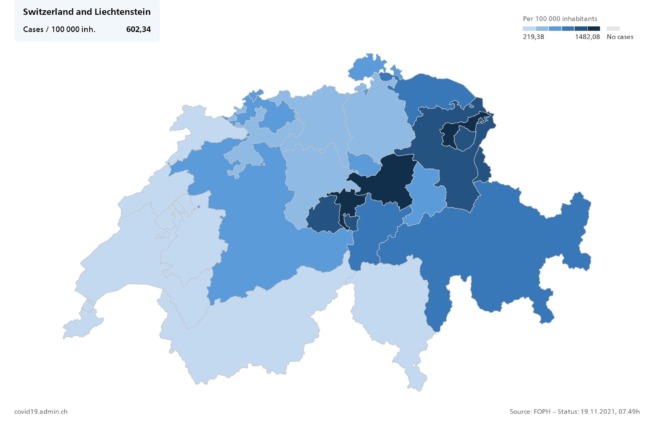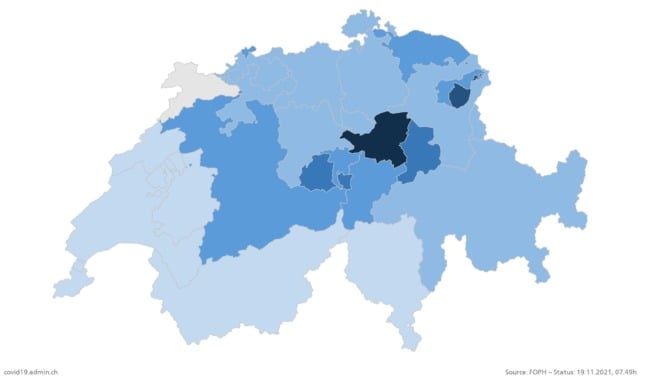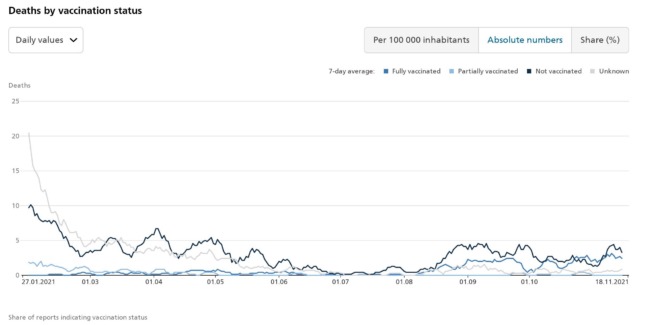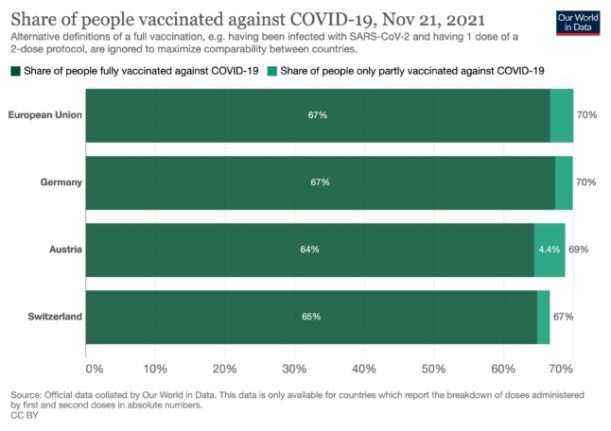MAPS: Where are Switzerland’s coronavirus hotspots right now?

The number of infections has risen significantly in Switzerland in the past weeks, reaching levels similar to those recorded in November 2020. Here’s an overview.
From about 1,600 new cases at the end of September, the number of infections has soared exponentially to 6,169 on November 19th, mirroring the epidemiological situation at the same time in 2020, when over 6,700 new contaminations had been recorded in Switzerland.
READ MORE: Is Switzerland delaying imposing new measures due to Covid referendum?
However, there are some differences between then and now.
In the fall of 2020, swathes of the country and linguistic regions had been impacted. Right now, the pockets of infection are concentrated in eastern and central Switzerland, with contamination rates in Appenzell Ausserrhoden, Schwyz, Nidwalden, Obwalden, and St. Gallen double the national average of 602,34 cases per 100,000 inhabitants..
This chart from the Federal Office of Public Health (FOPH) shows where the hotbeds of infection are currently.
The rate of infections in French-speaking cantons and Ticino, on the other hand, is well below the national average, contrary to the fall of 2020, when these regions, especially Geneva, were among the hardest hit.
Another major difference between now and the same period in 2020 is the number of Covid-related hospitalisations and deaths.
Hospital admissions
In mid-November of last year, 262 coronavirus patients were hospitalised in intensive care units; this number is currently 154.
The vast majority of these patients are in Appenzell Innerrhoden and Schwyz.

The relatively low and geographically contained current hospitalisation rate is the reason why Switzerland announced on November 18th that it will not be following Germany and Austria’s lead of restricting bars, restaurants and events to the fully vaccinated and those recovered from the virus
READ MORE: Switzerland rules out making restaurants ‘vaccinated only’ despite Covid case record
FOPH statistics also shed light on the number of vaccinated versus unvaccinated Covid patients: as this chart shows, far more unvaccinated people were admitted to hospitals.

Deaths
Despite the spike of infections, deaths from coronavirus have remained relatively low — 15 new deaths as of November 19th versus 97 for the same period in 2020. Most were recorded in Appenzell Innerrhoden, with several cantons not reporting any deaths at all.
Here, as in case of hospitalisations, deaths among the unvaccinated are higher than among the immunised, despite (misleading) claims to the contrary.

READ MORE: Covid-19 in Switzerland: Why number of deaths among the vaccinated is misinterpreted
However, both hospitalisation and death numbers reported by FOPH are between several days and two weeks delayed, so it is more than likely that the real rates are higher.
What is the epidemiological outlook for the coming weeks?
So far, the pattern is in line with predictions by health experts who forecast the worsening of the situation with the arrival of cold weather, which drives people indoors where the virus can spread more easily.
READ MORE: Covid-19 in Switzerland: The situation is improving, but will it last?
Also, while a number of people received their shots during the Vaccination Week from November 8th to 14th, Switzerland’s inoculation rate still lags behind the EU’s, which means a large proportion of the population remains unprotected against coronavirus.

Image: Our World in Data
All this indicates that the number of infections is likely to keep going up in the near future.
Comments
See Also
From about 1,600 new cases at the end of September, the number of infections has soared exponentially to 6,169 on November 19th, mirroring the epidemiological situation at the same time in 2020, when over 6,700 new contaminations had been recorded in Switzerland.
READ MORE: Is Switzerland delaying imposing new measures due to Covid referendum?
However, there are some differences between then and now.
In the fall of 2020, swathes of the country and linguistic regions had been impacted. Right now, the pockets of infection are concentrated in eastern and central Switzerland, with contamination rates in Appenzell Ausserrhoden, Schwyz, Nidwalden, Obwalden, and St. Gallen double the national average of 602,34 cases per 100,000 inhabitants..
This chart from the Federal Office of Public Health (FOPH) shows where the hotbeds of infection are currently.
The rate of infections in French-speaking cantons and Ticino, on the other hand, is well below the national average, contrary to the fall of 2020, when these regions, especially Geneva, were among the hardest hit.
Another major difference between now and the same period in 2020 is the number of Covid-related hospitalisations and deaths.
Hospital admissions
In mid-November of last year, 262 coronavirus patients were hospitalised in intensive care units; this number is currently 154.
The vast majority of these patients are in Appenzell Innerrhoden and Schwyz.

The relatively low and geographically contained current hospitalisation rate is the reason why Switzerland announced on November 18th that it will not be following Germany and Austria’s lead of restricting bars, restaurants and events to the fully vaccinated and those recovered from the virus
READ MORE: Switzerland rules out making restaurants ‘vaccinated only’ despite Covid case record
FOPH statistics also shed light on the number of vaccinated versus unvaccinated Covid patients: as this chart shows, far more unvaccinated people were admitted to hospitals.

Deaths
Despite the spike of infections, deaths from coronavirus have remained relatively low — 15 new deaths as of November 19th versus 97 for the same period in 2020. Most were recorded in Appenzell Innerrhoden, with several cantons not reporting any deaths at all.
Here, as in case of hospitalisations, deaths among the unvaccinated are higher than among the immunised, despite (misleading) claims to the contrary.

READ MORE: Covid-19 in Switzerland: Why number of deaths among the vaccinated is misinterpreted
However, both hospitalisation and death numbers reported by FOPH are between several days and two weeks delayed, so it is more than likely that the real rates are higher.
What is the epidemiological outlook for the coming weeks?
So far, the pattern is in line with predictions by health experts who forecast the worsening of the situation with the arrival of cold weather, which drives people indoors where the virus can spread more easily.
READ MORE: Covid-19 in Switzerland: The situation is improving, but will it last?
Also, while a number of people received their shots during the Vaccination Week from November 8th to 14th, Switzerland’s inoculation rate still lags behind the EU’s, which means a large proportion of the population remains unprotected against coronavirus.

Image: Our World in Data
All this indicates that the number of infections is likely to keep going up in the near future.
Join the conversation in our comments section below. Share your own views and experience and if you have a question or suggestion for our journalists then email us at [email protected].
Please keep comments civil, constructive and on topic – and make sure to read our terms of use before getting involved.
Please log in here to leave a comment.